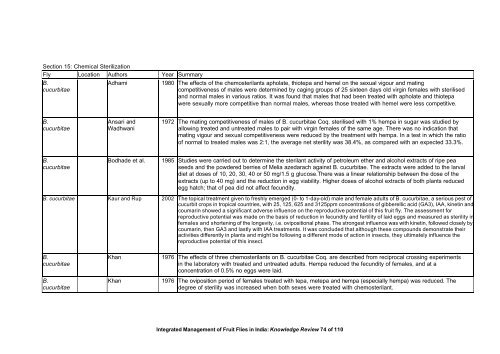“Key Informant Survey” of Production, Value, Losses and ... - DfID
“Key Informant Survey” of Production, Value, Losses and ... - DfID
“Key Informant Survey” of Production, Value, Losses and ... - DfID
You also want an ePaper? Increase the reach of your titles
YUMPU automatically turns print PDFs into web optimized ePapers that Google loves.
Section 15: Chemical Sterilization<br />
Fly Location Authors Year Summary<br />
B.<br />
cucurbitae<br />
B.<br />
cucurbitae<br />
B.<br />
cucurbitae<br />
Adhami 1980 The effects <strong>of</strong> the chemosterilants apholate, thiotepa <strong>and</strong> hemel on the sexual vigour <strong>and</strong> mating<br />
competitiveness <strong>of</strong> males were determined by caging groups <strong>of</strong> 25 sixteen days old virgin females with sterilised<br />
<strong>and</strong> normal males in various ratios. It was found that males that had been treated with apholate <strong>and</strong> thiotepa<br />
were sexually more competitive than normal males, whereas those treated with hemel were less competitive.<br />
Ansari <strong>and</strong><br />
Wadhwani<br />
1972 The mating competitiveness <strong>of</strong> males <strong>of</strong> B. cucurbitae Coq. sterilised with 1% hempa in sugar was studied by<br />
allowing treated <strong>and</strong> untreated males to pair with virgin females <strong>of</strong> the same age. There was no indication that<br />
mating vigour <strong>and</strong> sexual competitiveness were reduced by the treatment with hempa. In a test in which the ratio<br />
<strong>of</strong> normal to treated males was 2:1, the average net sterility was 38.4%, as compared with an expected 33.3%.<br />
Bodhade et al. 1985 Studies were carried out to determine the sterilant activity <strong>of</strong> petroleum ether <strong>and</strong> alcohol extracts <strong>of</strong> ripe pea<br />
seeds <strong>and</strong> the powdered berries <strong>of</strong> Melia azedarach against B. cucurbitae. The extracts were added to the larval<br />
diet at doses <strong>of</strong> 10, 20, 30, 40 or 50 mg/1.5 g glucose.There was a linear relationship between the dose <strong>of</strong> the<br />
extracts (up to 40 mg) <strong>and</strong> the reduction in egg viability. Higher doses <strong>of</strong> alcohol extracts <strong>of</strong> both plants reduced<br />
egg hatch; that <strong>of</strong> pea did not affect fecundity.<br />
B. cucurbitae Kaur <strong>and</strong> Rup 2002 The topical treatment given to freshly emerged (0- to 1-day-old) male <strong>and</strong> female adults <strong>of</strong> B. cucurbitae, a serious pest <strong>of</strong><br />
cucurbit crops in tropical countries, with 25, 125, 625 <strong>and</strong> 3125ppm concentrations <strong>of</strong> gibberellic acid (GA3), IAA, kinetin <strong>and</strong><br />
coumarin showed a significant adverse influence on the reproductive potential <strong>of</strong> this fruit fly. The assessment for<br />
reproductive potential was made on the basis <strong>of</strong> reduction in fecundity <strong>and</strong> fertility <strong>of</strong> laid eggs <strong>and</strong> measured as sterility in<br />
females <strong>and</strong> shortening <strong>of</strong> the longevity, i.e. ovipositional phase. The strongest influence was with kinetin, followed closely by<br />
coumarin, then GA3 <strong>and</strong> lastly with IAA treatments. It was concluded that although these compounds demonstrate their<br />
activities differently in plants <strong>and</strong> might be following a different mode <strong>of</strong> action in insects, they ultimately influence the<br />
reproductive potential <strong>of</strong> this insect.<br />
B.<br />
cucurbitae<br />
B.<br />
cucurbitae<br />
Khan 1976 The effects <strong>of</strong> three chemosterilants on B. cucurbitae Coq. are described from reciprocal crossing experiments<br />
in the laboratory with treated <strong>and</strong> untreated adults. Hempa reduced the fecundity <strong>of</strong> females, <strong>and</strong> at a<br />
concentration <strong>of</strong> 0.5% no eggs were laid.<br />
Khan 1976 The oviposition period <strong>of</strong> females treated with tepa, metepa <strong>and</strong> hempa (especially hempa) was reduced. The<br />
degree <strong>of</strong> sterility was increased when both sexes were treated with chemosterilant.<br />
Integrated Management <strong>of</strong> Fruit Flies in India: Knowledge Review 74 <strong>of</strong> 110

















